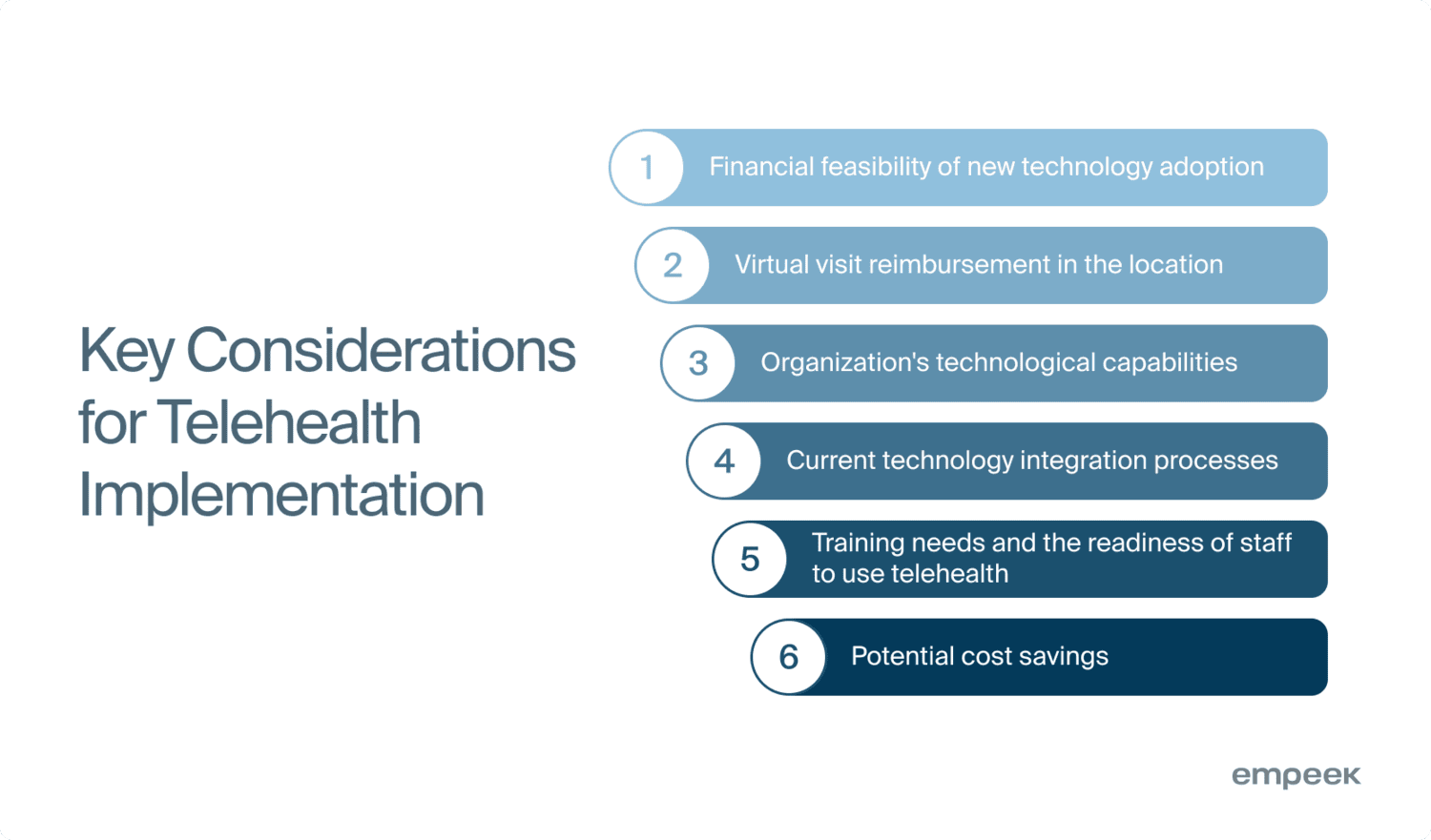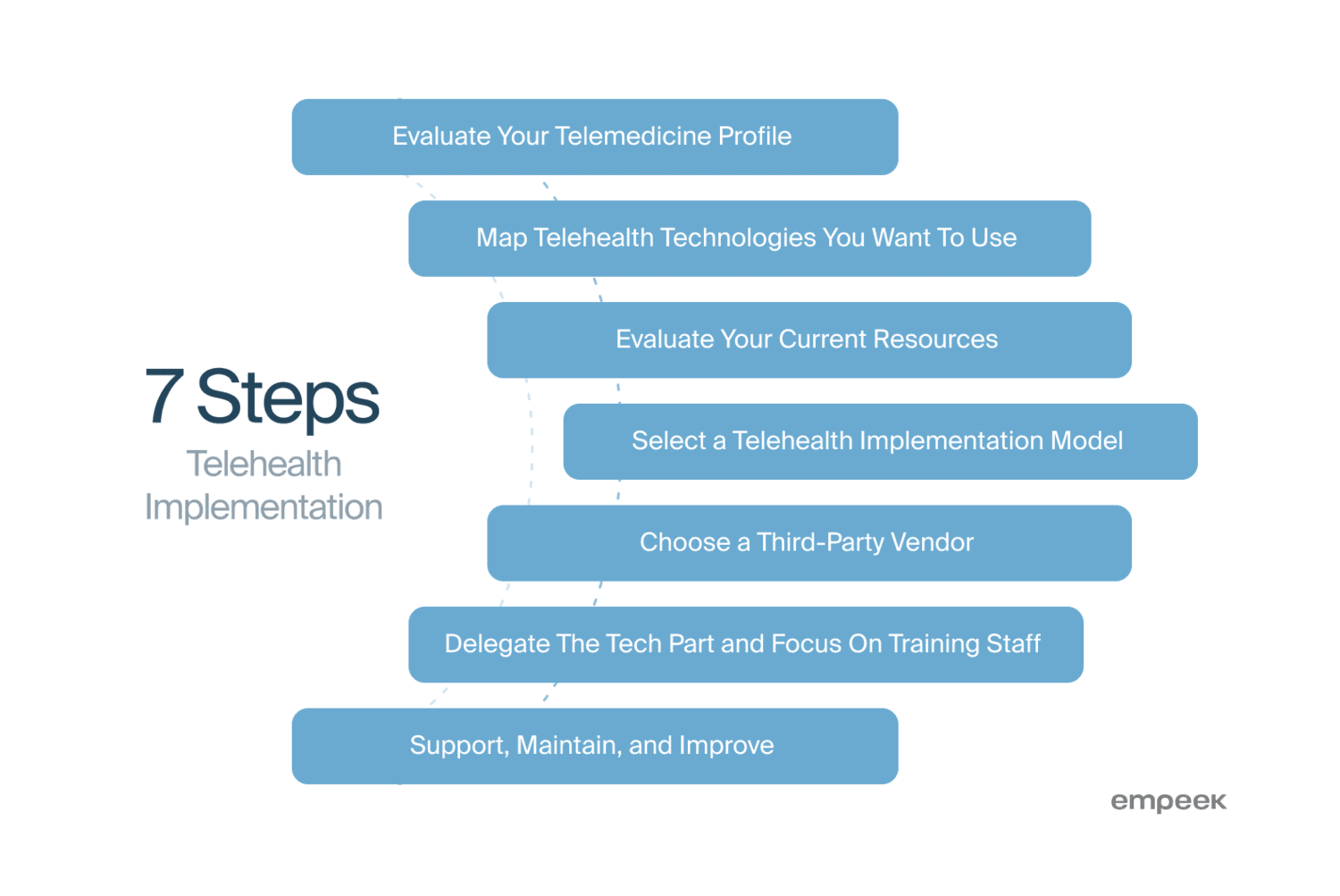Implementing telehealth isn’t something you can do in a day. You need careful planning and a thoughtful approach to make everything right. You should start by exploring organizations that have already adopted telehealth. What has worked for them? Where have they failed? Learning from their wins and falls in telehealth implementation will save you lots of time, nerves, and money.
Another thing to do is define your business needs. Make a thorough assessment and use it as a foundation to understand why and how to adopt telehealth.
Find more details, success stories, and steps of telehealth implementation in our post.
Stories of Successful Telehealth Program Implementation
Let’s explore case studies of successful telehealth implementations from leading healthcare organizations presented in Deloitte‘s report. These projects feature different telehealth uses, from tracking chronic illnesses to specialized online medical programs and systems to manage medications.
Health monitoring from patient’s home
The non-profit health system developed a program to monitor physiological health remotely, focusing initially on 348 heart failure patients. The aim of the program was to reduce readmissions and boost patient health through self-checks and doctor reviews. It led to a big drop in heart failure patients returning to the hospital and fewer deaths. The program also considerably improved patient satisfaction.
Early warning software and remote monitoring tools
The health system of 46 hospitals and over 700 physician practices implemented remote eICU monitoring using external vendors. The program supports critical care units with early warning software and remote monitoring tools. Thanks to this, off-site critical care teams can assist staff at the bedside through voice, video, and body signal tracking. This effort significantly impacted ICU death rates and how long patients stayed, cut down on nurses quitting, and made patients happier with their care.
Critical care extension through telehealth eICU
A part of a health system with 34 hospitals, this 371-bed hospital adopted remote eICU monitoring to extend critical care expertise from an urban hub to three remote locations. The eICU team monitors key health signs with cameras and body sensors and steps in when necessary. This prevents expensive air ambulance trips and ensures patients in far-off places get the care they need on time.
Telehealth medication dispensers
The organization, which includes 7 hospitals and 38 medical centers, deployed telehealth medication dispensers for over 230 senior patients at risk of medication mismanagement. These devices dispense medications according to schedule and provide reminders, with alerts sent to caregivers if patients miss a dose. This method contributed to a 98% compliance rate. It also reduced doctor appointments and hospital stays compared to old-fashioned pillbox systems.
Video collaboration tools and Bluetooth-enabled stethoscopes
The hospital implemented multidisciplinary video collaboration and Bluetooth-enabled electronic stethoscopes to connect rural hospitals with cardiology, oncology, and bariatric care specialist services. With the help of telehealth implementation, the hospital reduced readmissions, achieved a 100% return on investment within two months, and improved access to high-quality care for rural obese patients.
These real-life cases highlight how telehealth technology is revolutionizing healthcare and bringing tangible results. It makes care more efficient, improves treatment outcomes, and optimizes the work of medical staff. As healthcare organizations continue implementing telehealth into everyday practice, it starts playing a key role in molding the future of medicine.
Read about 5 Telehealth Trends That Will Shape the Market
7 Steps Towards Telehealth Implementation
As healthcare providers face the challenges of integrating telehealth into their practices, they need a detailed plan to adopt new software. We outline seven key steps to help organizations move from examining telehealth to implementing it.
Step 1: Evaluate Your Telemedicine Profile
To assess your telemedicine capabilities effectively, analyze your current infrastructure and operational needs. Consider standard telemedicine services such as virtual visits for routine care, remote patient monitoring for chronic condition management, and telehealth consultations for specialized medical advice. To build your telemedicine profile, you must understand these service offerings and see how they match your organization’s goals.
Figure out which patient groups you want to help, such as older patients who need ongoing care for long-term illnesses or people in rural areas looking for specialized healthcare services. This will help you create a telehealth plan focused on your patients’ needs and specifics of care.

Step 2: Map Telehealth Technologies You Want to Use
When planning your telehealth technology strategy, check available telehealth options and determine which of them meets your organization’s goals. It’s a tried and tested way to validate your telehealth implementation ideas.
For example, virtual visits using video conferencing platforms like Zoom or Microsoft Teams are ideal for remote patient consultations. Remote monitoring devices such as home blood pressure monitors or glucometers can transmit real-time data to healthcare providers to manage chronic diseases. Secure messaging systems, like MyChart or other secure patient portals, ensure confidential communication between medical staff and patients.
To evaluate telehealth options, you should consider:
| Integration capabilities | Smooth integration with existing systems ensures seamless telehealth operation within the current infrastructure. |
| Scalability | Scalability is essential to be ready for a surge in patient volume. |
| Security | Strong data protection measures are a must to keep patient info safe and prevent leakage. |
| Regulatory compliance | Medical software must comply with healthcare laws like HIPAA. |
Step 3: Evaluate Your Current Resources
Once you know what tech solutions are suitable for you, assess your financial, technological, and human resources to implement them. Ensure adopting and maintaining new technologies is feasible, taking into account potential cost savings from reduced hospital admissions and improved patient outcomes. Besides, check your organization’s tech abilities to ensure it can handle increased load and keep data safe.
Finally, assess your staff’s readiness and identify training needs to ensure they can effectively use telehealth technologies. Training will help your team provide better care and get patients more involved through online health platforms.

Step 4: Select a Telehealth Implementation Model
When choosing a telehealth implementation model, healthcare providers have two primary options: integrating solutions from existing vendors or investing in custom development. Each method has its pros and cons.
Integrating off-the-shelf solutions, you adopt different types of ready-made platforms that are typically scalable and well-supported. These platforms often have built-in video calls, remote patient monitoring, and safe data transmission. They also follow the healthcare industry’s regulatory standards.
Alternatively, you can build a telehealth app tailored to your organization. This model works well if you need unique functionality, ultimate security, and customization. Such software is usually more convenient for users and runs smoothly in complicated health settings. It also gives you a competitive advantage since you can offer something other companies don’t provide.
Whether integrating off-the-shelf solutions or opting for custom development, you must ensure compatibility with your existing infrastructure and scalability for future growth. Empeek specializes in tailored telehealth solutions that optimize patient care and streamline healthcare delivery. Contact us to learn how our services can support your telehealth implementation plan.
Step 5: Choose a Third-Party Vendor
Selecting the right third-party vendor for telehealth implementation or development is critical to the success of your initiative. Here are some key things to consider when choosing a telehealth implementation vendor:
| Experience and expertise | Look for vendors that have been in the market for a while and have skills to build platforms that meet industry standards. |
| Scalability and flexibility | Evaluate the vendor’s ability to scale their solutions according to your organization’s needs. Ensure the software can accommodate growth in patient volume and adapt to evolving telehealth requirements. |
| Interoperability | Verify that the vendor’s software integrates with your existing electronic health record (EHR) systems and other IT infrastructure. |
| Security and compliance | Prioritize vendors that adhere to strict data security measures and comply with healthcare regulations, such as HIPAA. Keeping patient data confidential and ensuring data integrity are crucial in telehealth operations. |
| Customer support and training | Check the vendor’s customer support services. How easy are they to reach? How fast do they respond? They should offer comprehensive training for your staff on using the telehealth software and fixing common problems. |
When picking a vendor for custom software development, ensure they can customize the software to fit your needs, including features, user interfaces, and workflows. Check out their development method, giving preference to Agile approaches that let you make progress step by step and adjust based on feedback. Solid project management and communication are key, so ensure the vendor gives you a dedicated project manager and regular updates. Discuss the overall cost, including hidden fees, to stay within budget without compromising quality. Don’t forget to check the vendor’s reputation by asking for references or case studies to ensure they deliver projects reliably and on time.
Paying attention to these factors can help you select a telehealth vendor that matches your organization’s needs and backs up your telehealth implementation strategy.
Step 6: Delegate the Tech Part and Focus on Training Staff
Once you’ve selected a vendor, delegate the technical tasks to external specialists. They will configure the software, integrate it with existing systems, and set up security measures.
You need to make training your healthcare staff a top priority. Give them thorough lessons on how to use the telehealth platform. Education makes sure your team can provide top-notch care through telehealth.
Step 7: Support, Maintain, and Improve
Telehealth implementation doesn’t end with deployment — it requires ongoing support, maintenance, and continuous improvement:
| Support | Establish a support system to assist staff and patients with technical issues, troubleshooting, and user guidance. |
| Maintenance | Regularly update the telehealth software to incorporate new features, enhance security protocols, and optimize performance. Monitor system performance and address any issues promptly to minimize disruptions. Empeek offers software maintenance services and can help you keep your telehealth software updated and secure. |
| Continuous improvement | Get feedback from medical staff and patients to spot areas you can improve. Use data analytics to check telehealth usage patterns, patient outcomes, and how well things run. This gives a comprehensive view of the telehealth program’s efficiency and allows for maximizing its output through regular enhancements. |
Telehealth implementation requires careful planning to ensure patients and healthcare providers get the best results in the short- and long-term. Organizations can use telehealth to boost patient care, optimize administrative workflows, and improve overall healthcare quality.

Cost of Implementing Telehealth
The cost of telehealth implementation can vary widely, influenced by several critical factors, including the complexity of the telehealth platform, customization needs, and scalability requirements.
What’s more, choosing between building custom telehealth software or using existing vendor solutions impacts costs. Custom development offers tailored functionalities but is more costly due to development time and specialized features. Alternatively, off-the-shelf solutions provide quicker telehealth implementation but may require additional customization to align with specific organizational workflows, affecting overall expenses accordingly.
Read our article on how much does it cost to implement telehealth for a detailed breakdown of telehealth implementation costs.
Our Experience with Telemedicine Implementation
At Empeek, we have successfully completed telehealth development and implementation projects for 8+ years. These are some of the solutions we have developed.
Remote Patient Monitoring Solution Development
We have developed a remote patient monitoring solution for chronic disease management that monitors vital signs and symptoms. It includes a platform connected to wearable devices that collects and analyzes data in real-time. Software implementation has led to fewer emergency visits and hospital stays, improving patient outcomes.
Healthcare Integration – Upvio and Elation EHR
We have successfully integrated telehealth capabilities into the EHR system to optimize patient management and clinical workflows. By customizing the Upvio telehealth platform, we enabled seamless virtual visits, secure medical record sharing, and remote patient communication within the EHR framework. This integration has significantly enhanced provider efficiency and patient satisfaction. The final product improved patient access to care and enhanced collaboration among healthcare teams.
Conclusion
Telemedicine implementation is a complex process that starts with figuring out what your organization needs. Then, you need to calculate the budget, choose trustworthy vendors, adopt the new system, and train medical staff to use it.
Implementing telehealth isn’t just about using new tech — it’s about changing how we provide healthcare, ensuring it stays focused on patients, works well, and is easy to access. Using the tips and experiences shared here, healthcare providers can handle the tricky parts of setting up telehealth.
Our skilled team is ready to help you set up telehealth. Contact us today to discover how we can help you implement telehealth.








